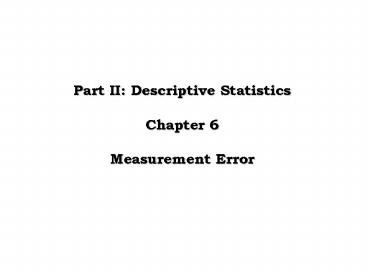Part II: Descriptive Statistics Chapter 6 Measurement Error PowerPoint PPT Presentation
1 / 6
Title: Part II: Descriptive Statistics Chapter 6 Measurement Error
1
Part II Descriptive StatisticsChapter 6
Measurement Error
2
Measurement Error
Repeated measurements of an object do NOT
produce the same result - the observed
differences are due to chance error example
weigh yourself on a bathroom scale questions
about chance error where do they come
from? how big are they? We can assess how
large these are by replicating the
measurement National Bureau of Standards in
Washington holds the national stds for weights
and measures (K20 (kilogram 20), NB 10 (10
grams) used to calibrate weights in the
U.S. these have been repeatedly weighed under
the same conditions (room, apparatus, people,
procedure, air pressure, temp) attempted to
control all factors that may influence the
weight NB10 weights are the same to the first 3
decimal places then they differ (Table 1, p99)
3
Estimating chance error
The standard deviation (average of the
differences) estimates the likely size of the
chance error in a single measurement Note
individual measurement exact value chance
error
varies
a constant
repeated individual
measurements differ due to chance error
variability their standard deviation estimates
the chance error or variability for any single
measurement
standard deviation R.M.S. of the deviations from
the average
4
Outliers
Extreme scores that are not the result of
errors Table 1 data 36, 86 and 94 very
extreme numbers that seldom occur
94 -5 z 36 3 z 86
5 z
99.87 below 00.13 at/above
4 z 99.997 below 00.003
at/above
(OH fig 2, p102) with these in mean 405
micrograms below 10 grams SD 6 micrograms 86
fall within 1 SD of average
Effect of outliers inflate the average and SD
with these out
mean 404 micrograms below 10 grams SD 4
micrograms closer to 68 within 1 SD of average
5
Bias
A systematic influence in the same
direction NOT random random/chance sometime
positive, sometimes negative systematic always
in only one direction Now ind
ividual measurement exact value bias chance
error Without bias the long run
average of repeated measurements variables
exact value known as the EXPECTED VALUE With
bias long run average will be off in the same
direction as the bias Note bias does not equal
chance error
6
Chapter 6 Concept Review
- All measurements, no matter how carefully
made, may differ - reflects chance error
- So individual measurement true value
chance error - Researchers need to estimate the likely size
of chance error before relying on a - single measurement best method is via
replication - Likely size of chance error in a single
measurement is estimated by the standard - deviation of a series of replicated measurements
- Bias/systematic error causes measurements
to be systematically too high/low - individual measurement true value bias
chance error - Even in careful measurement, we can expect a
small percentage of outliers - these can strongly influence the average and the
SD

